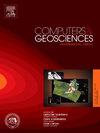以钻孔和露头接触为条件的地质几何特征的知识驱动随机建模
IF 4.4
2区 地球科学
Q1 COMPUTER SCIENCE, INTERDISCIPLINARY APPLICATIONS
引用次数: 0
摘要
地球科学中的几何特征对于理解近地表和更深层次的地球内部结构至关重要。传统上,几何特征是通过不同的数据源来描绘的,比如地表测绘、地球物理和岩心样本。然而,在模型构建中,地质知识和见解与地球科学数据的定量整合仍然没有得到充分的解决。我们制定了一个新的框架,采用随机水平集模拟地下几何特征。我们的框架的独特性涉及到地质知识,由二维地质图表示,在使用Procrustes分析的数值模拟中。我们通过旋转、缩放和平移等转换来解释地质图的可变性和不确定性。通过使用设计的损失函数,所得到的模型与已建立的地质知识保持一致,并以钻孔和地面观测(即露头接触)的岩性为条件。我们将该方法应用于安大略省西北部水晶湖辉长岩(CLG)基性侵入岩中的Cu-Ni-PGE(铜镍铂族元素)远景区。我们的研究主要集中在y形CLG的单个片段上。该应用的数值结果表明,结合专家知识、钻孔和地面数据,可以得到具有可靠地质几何特征的模型,特别是与经济矿化高度相关的侵入模型的底边界分布。本文章由计算机程序翻译,如有差异,请以英文原文为准。
Knowledge-driven stochastic modeling of geological geometry features conditioned on drillholes and outcrop contacts
Geometry features in geosciences are crucial for understanding both near-surface and deeper Earth’s interior structures. Geometry features have traditionally been delineated through diverse data sources such as surface mapping, geophysics, and core samples. However, the quantitative integration of geological knowledge and insights with the geoscientific data remains insufficiently addressed in the model construction. We have formulated a novel framework that employs stochastic level set simulation to model subsurface geometric features. The uniqueness of our framework involves geological knowledge, represented by two-dimensional (2D) geological diagrams, in the numerical modeling using Procrustes analysis. We account for the geological diagrams’ variability and uncertainty through transformations such as rotation, scaling, and translation. By using the designed loss functions, the resulting models align with the established geological knowledge and are also conditioned on the lithology from drillhole and surface observations (i.e., outcrop contacts). We apply the methodology to a field study of a Cu-Ni-PGE (copper-nickel-platinum group element) prospect hosted in a mafic intrusion, the Crystal Lake Gabbro (CLG), in northwest Ontario. Our study focuses on a single segment of the y-shaped CLG. The numerical outcomes of this application demonstrate that the incorporation of expert knowledge, drillholes, and surface data yields models with reliable geological geometry features, particularly the distribution of bottom boundary for intrusion models which is highly associated with economic mineralization.
求助全文
通过发布文献求助,成功后即可免费获取论文全文。
去求助
来源期刊

Computers & Geosciences
地学-地球科学综合
CiteScore
9.30
自引率
6.80%
发文量
164
审稿时长
3.4 months
期刊介绍:
Computers & Geosciences publishes high impact, original research at the interface between Computer Sciences and Geosciences. Publications should apply modern computer science paradigms, whether computational or informatics-based, to address problems in the geosciences.
 求助内容:
求助内容: 应助结果提醒方式:
应助结果提醒方式:


